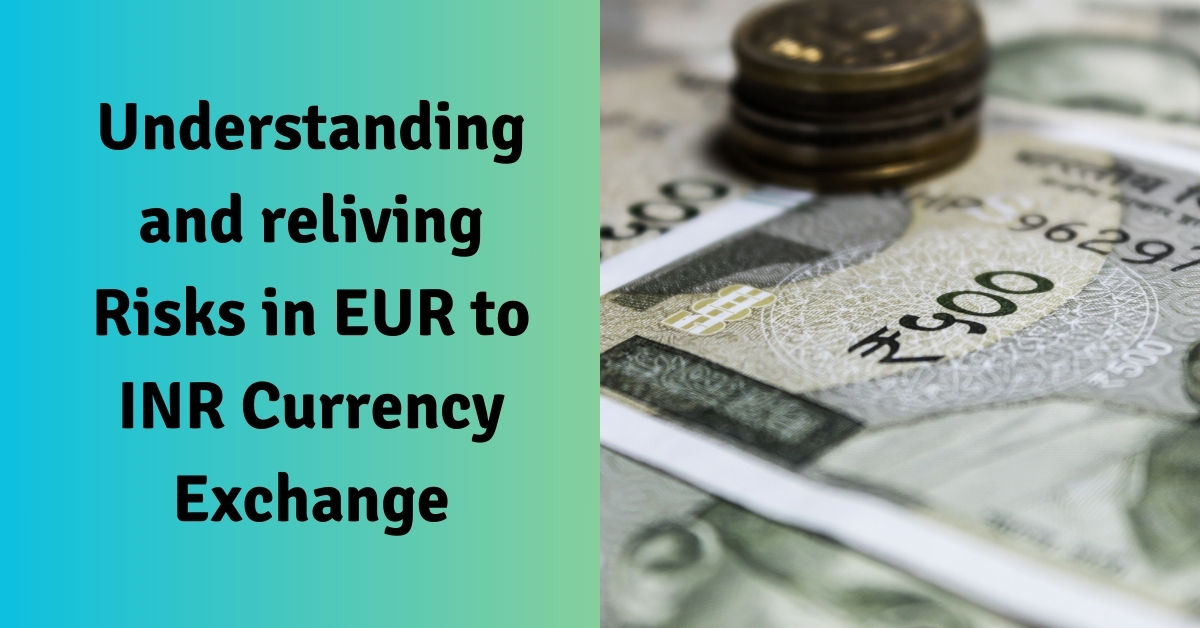Understanding and reliving Risks in EUR to INR Currency Exchange
Consider a scenario where an Italian clothing retailer sources silk from India at a price set in Indian rupees. A geopolitical incident causes the Euro to depreciate against the rupee, resulting in the Italian business paying more Euros for the same amount of fabric. This example illustrates the significance of exchange rates in global commerce and finance.
The Bank for International Settlements reports that the foreign exchange market’s daily trading volume reached an average of $7.5 trillion in April 2022. This figure underscores the market’s enormous scale and volatility, emphasizing the importance for those involved in currency transactions to comprehend and address associated risks.
This article will explore the risks of exchanging EUR to INR, offering a thorough explanation of these risks and strategies for businesses and investors to manage them effectively.
Defining Currency Risk
Currency risk, also referred to as exchange-rate risk, stems from fluctuations in one currency’s value relative to another. This risk can lead to unexpected gains or losses for investors, businesses, and organizations with cross-border assets or operations.
Categories of Foreign Exchange Risks
Foreign exchange risks can be classified into:
- Transaction Risk: Arising from cross-border financial transactions.
- Economic Risk: Also known as forecast risk, it refers to the long-term effect of currency fluctuations on a company’s market value, influenced by macroeconomic factors like geopolitical events, economic policies, and market conditions.
- Translation Risk: Affecting companies that keep financial records in a currency different from their operational currency, where exchange rate fluctuations can impact reported earnings and financial position during consolidation of financial statements.
Factors Affecting the EUR to INR Exchange Rate
- Interest Rates: Disparities in interest rates between the Eurozone and India influence capital flows and exchange rates.
- Economic Indicators: Metrics such as GDP growth, inflation rates, and unemployment figures impact the exchange rate.
- Political Stability: Political events, policy shifts, and geopolitical tensions create uncertainty and volatility in currency markets.
Strategies to Mitigate Currency Risk
- Hedging
- Utilize financial instruments like forward contracts, options, and futures to secure exchange rates.
- Provides protection against unfavorable currency movements.
- Diversification
- Spread operations and revenue streams across multiple countries and currencies.
- Reduces the impact of currency fluctuations in any single market.
- Monitoring Economic Indicators
- Keep track of economic indicators and geopolitical developments in the Eurozone and India.
- Aids in anticipating potential currency movements and making informed decisions.
- Selecting Reliable Financial Institutions
- Partner with banks and financial institutions offering competitive exchange rates and efficient services.
- Facilitates more effective management of currency risk.
Forward Contracts: A Tool for Mitigating Currency Exchange Risk
A forward contract is an agreement between two parties to exchange a specific amount of one currency for another at a predetermined exchange rate on a future date. This type of contract allows businesses to secure an exchange rate now for a future transaction.
Advantages of Forward Contracts
- Price Certainty: Forward contracts provide businesses with certainty about future exchange rates, eliminating guesswork and aiding in budgeting and planning.
- Risk Mitigation: By locking in an exchange rate, businesses can protect themselves from unfavorable currency movements that could increase costs or reduce profits.
- Competitive Advantage: Forward contracts offer stability, which can be a significant competitive edge, especially in markets with high exchange rate volatility.
Conclusion
Grasping the risks associated with EUR to INR currency exchange is vital for businesses and investors engaged in international transactions. Understanding the types of currency risks, factors influencing exchange rates, and employing risk mitigation strategies can safeguard financial positions and enhance performance.
Frequently Asked Questions
1. How do exchange rate fluctuations impact the risk of EUR-to-INR currency exchange?
Ans- Exchange rate fluctuations can cause variability in the amount received when converting EUR to INR, potentially affecting investment profitability and transaction costs. Sudden changes can result in financial losses or gains, increasing uncertainty and risk in currency exchange.
2. How do economic factors and geopolitical events influence EUR to INR currency exchange risk?
Ans- Economic factors like inflation rates, interest rates, GDP growth, and geopolitical events such as elections and policy changes can significantly impact the EUR to INR exchange rate. These factors create volatility and uncertainty, increasing currency exchange risk.
3. Are there specific timeframes or market conditions that present higher risk when exchanging EUR for INR?
Ans- Exchanging EUR to INR during periods of economic instability, market volatility, or major political events can present higher risks.
4. What regulatory or compliance risks should individuals consider when exchanging EUR to INR?
Ans- Individuals should be aware of regulatory requirements under FEMA (India), Foreign Conduct Authority (UK), Foreign Trade and Payment Act (Germany), and anti-money laundering laws in the Eurozone and India. Non-compliance with these regulations can result in legal penalties.
5. How do different money transfer methods and providers vary in terms of risk for EUR to INR currency exchange?
Ans- Different money transfer methods and providers vary in fees, exchange rates, and transfer speed. Traditional banks offer more security but higher fees and slower transfers, while digital providers offer better rates and faster service but with potential security and reliability concerns.
6. How do central banks affect the EUR to INR exchange rate?
Ans- Central banks influence exchange rates by adjusting interest rates and monetary policies. For example, changes by the European Central Bank or the Reserve Bank of India can impact how much EUR is worth against INR.
7. How can businesses prepare for changes in exchange rates?
Ans- Businesses can use forecasting tools and stay updated on economic news. They can also use financial instruments like forward contracts to lock in rates and protect themselves from unexpected currency shifts.
8. How do trade balances and capital flows affect the EUR to INR rate?
Ans- Trade balances (the difference between exports and imports) and capital flows (money moving in and out) can impact the exchange rate. For instance, a trade deficit in India or capital outflows from the Eurozone can pressure the exchange rate.
9. How do political events in Europe and India affect currency risks?
Ans- Political changes, such as new policies or geopolitical issues, can create uncertainty and affect investor confidence, which in turn impacts the EUR to INR exchange rate.
10. What are the pros and cons of using tools like options and futures for managing currency risk?
Ans- Options and futures help businesses manage exchange rate risk by locking in rates or giving the right to buy or sell currency at set prices. They offer protection but can be costly and might not always align perfectly with actual needs.




